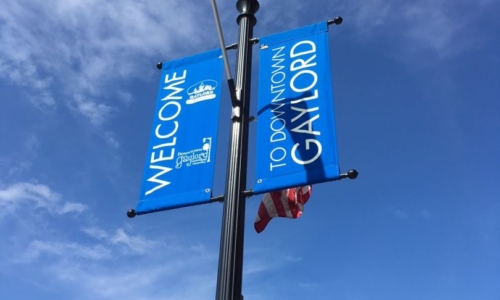Banner Brackets and Fly Fishing! – Part One

Did you know that Kalamazoo Banner Works was the very first company to use fiberglass arms for light pole banner mounting? Next time you’re near a vertical street banner look up to the hardware and see what’s holding that banner on the pole. On most vertical street-scape banners installed on city streets and shopping center parking lots (among other places) you will probably see that the arms or rods that go through the top and bottom hem of those banners is a white or off white rod of about 3/4″ in diameter. That technology, begun by us in late 1983 and now copied by virtually all bracket manufacturers, allows the wind force to be dissipated to some degree (by the flexing of the fiberglass rods) which puts less force onto the light pole and the base foundation. In addition, the fiberglass absorbs much of the vibration that occurs with prevailing wind currents and sudden gusts.Yes, that innovation came rather quickly after KBW started business as one of the first street banner manufacturers. When I started the company, the standard method of attaching these rather large banners, 30″ wide by 5′ to 8′ tall, onto utility poles was with steel arms of about 1″ in diameter welded to steel collars and bolted to the poles. I immediately noticed and became frustrated with the constant bending and permanent distortion that occurred with the steel brackets. When the brackets (pipes) bent permanently due to wind force, the banners became floppy and the would flutter more and more as the steel arms bent, and stayed bent, more and more. Eventually, as the amount of flapping increased and put incresed stress on the banner fabric and hems, it caused them to tear prematurely. This was most apparent in the city of Chicago where these types of banners originated. There the banners were always colorful and well printed but looked battle worn quickly after installation.As an architect and designer, I’ve had many chances to work through “the design process” and noodle through design challenges. This certainly was one of those! It just so happens that I was, at that same time, also attempting to learn how to fly fish with, as is common of course, a fiberglass rod. Well, there was the answer! “Pultruded” fiberglass flexes and always comes back to its original shape. The major challenge after deciding to use round fiberglass rods was to figure out what diameter to use and how to attach these to the poles. That next challenge also resulted in a solution that is also now copied by most companies who now use pultruded fiberglass for banner arms. I will leave the rest of the BannerFlex® story for the next writing.
Roger
Roger


